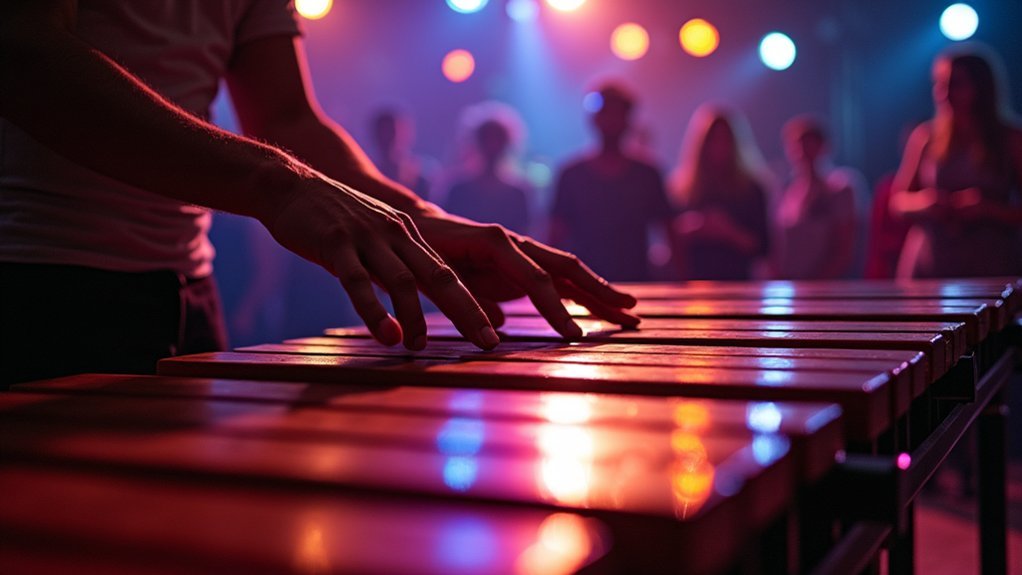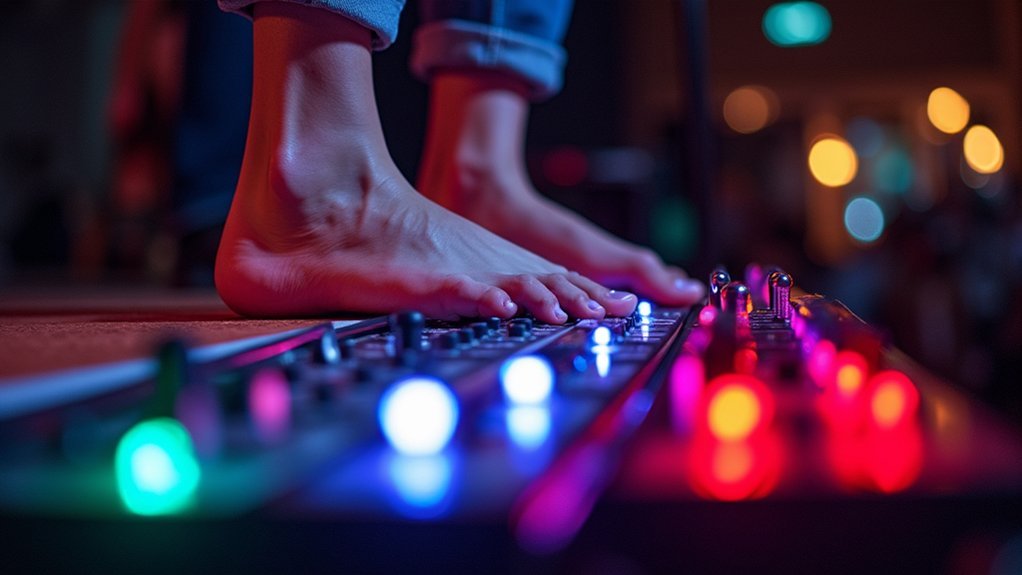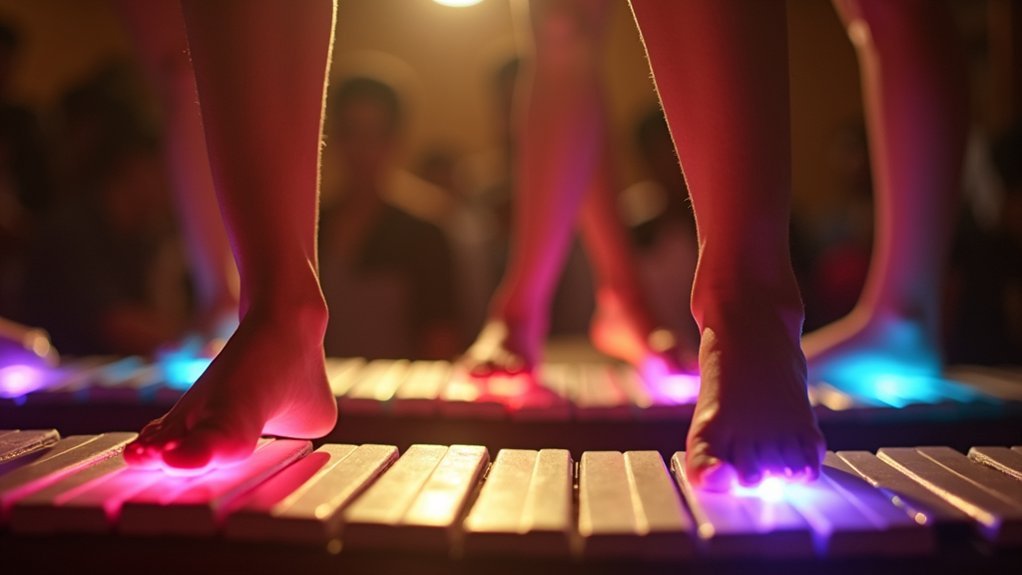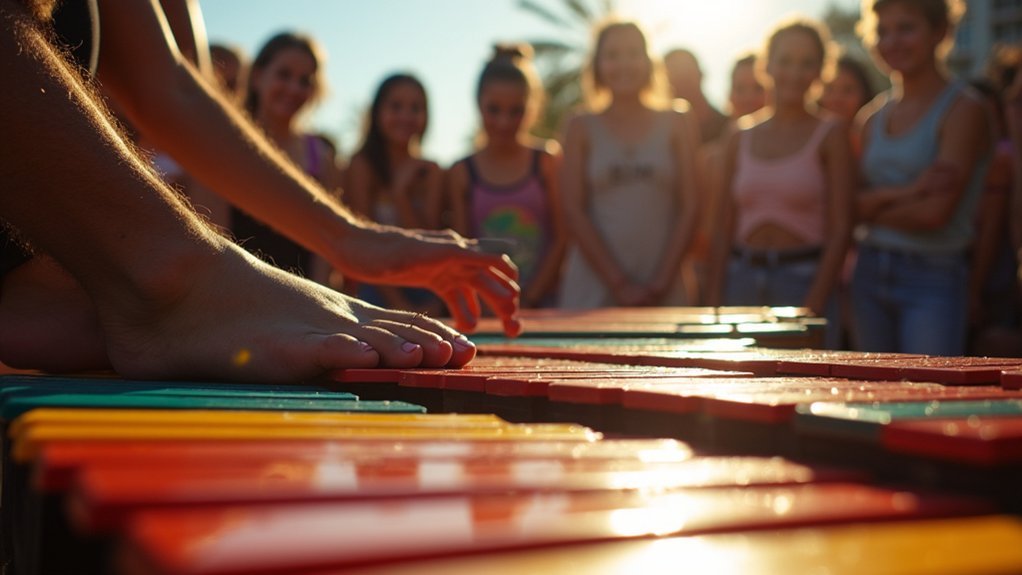Playing instruments with your feet offers unique musical possibilities when you face upper limb challenges or want to enhance your performance capabilities. You’ll develop specialized coordination while freeing your hands for other instruments or activities. Foot-operated devices—from pedal pianos to specialized synthesizers—create accessible pathways for musical expression while strengthening lower body muscles. This approach transforms potential limitations into distinctive artistic opportunities that can revolutionize your relationship with music.
Adapting Musical Expression for Upper Limb Challenges

While traditional musical performance often relies heavily on manual dexterity, playing instruments with your feet opens new possibilities for those facing upper limb challenges. By tapping into foot-operated devices specifically designed for this purpose, you can participate fully in music-making despite physical limitations.
Your creativity doesn’t diminish when adapting to foot playing—many musicians report it actually increases. Whether you’re using a foot piano or pedal-operated synthesizer, these adaptations allow you to express yourself musically without hand involvement.
Adapting to foot instrumentation often sparks greater creativity, unlocking fresh musical pathways beyond traditional techniques.
The innovation in this approach extends beyond necessity into new artistic territory. The beauty of this adaptation lies in how it transforms potential barriers into unique opportunities for musical expression.
You’ll discover that foot playing isn’t just a workaround—it’s a legitimate technique fostering diverse and novel performance styles.
Specialized Foot-Operated Instruments and Their Benefits
Specialized foot-operated instruments have evolved far beyond simple adaptations, offering unique musical possibilities for all performers regardless of physical ability.
Foot tambourines, synthesizer pedals, and stomp boxes let you maintain rhythm while your hands remain free for playing other instruments, creating a fuller sound during performance.
When you engage your feet with percussion instruments like the cajón or stomp box, you’ll add depth and texture to your music without sacrificing hand coordination.
The physical movement also enhances your stage presence, visually connecting with your audience while delivering complex musical arrangements.
Instruments featuring foot pedals—such as organs and pedal harps—provide remarkable control over dynamics and tonal variety.
This versatility sparks creativity, allowing you to seamlessly blend melodic elements with rhythmic foundations for a more compelling musical experience.
Building Coordination and Strength Through Pedal Performance

As you develop proficiency with foot-operated instruments, you’ll notice significant improvements in your overall musicality and physical capabilities. Your coordination will flourish as you learn to control pedals independently while managing complex hand movements. This multitasking builds strength in your lower body muscles essential for musical expression.
| Benefit | Physical Impact | Musical Result |
|---|---|---|
| Enhanced Coordination | Improved foot-hand independence | Smoother shifts between notes |
| Increased Strength | Developed foot muscles | Better dynamic control |
| Better Balance | Improved posture | More stable performance |
The timing and rhythm in your playing will become more intuitive as your feet become active participants in your musical expression. You’ll discover that pedal work isn’t just about hitting the right notes—it’s about transforming your entire body into a coordinated musical instrument.
Breaking Barriers With Accessible Instrument Modifications
The world of music-making has historically left many talented individuals on the sidelines due to physical limitations. Today, accessible instruments are changing this narrative, empowering everyone to create music regardless of mobility challenges.
Foot pedals and foot-operated controllers offer innovative solutions for musicians with limited hand mobility, ensuring inclusivity in performance and composition. These adaptive devices translate foot movements into musical expression, preserving creative independence while enhancing coordination skills.
Empowering musicians through adaptive technology that turns foot movements into melody, rhythm, and artistic autonomy.
Specialized equipment like the “foot piano” and “foot tambourine” invite diverse musicians to develop unique playing styles across multiple genres. Your physical engagement with these instruments can simultaneously improve motor skills and musical abilities.
Community initiatives increasingly support the development and availability of these modifications, breaking down barriers and ensuring everyone has access to the transformative power of making music.
Transforming Musical Therapy With Foot-Controlled Techniques

Musical therapy has expanded its horizons through innovative foot-controlled techniques, creating pathways for expression where traditional methods fall short.
When you engage your feet to play music, you’re not just making sounds—you’re developing coordination and revealing new therapeutic benefits.
These techniques incorporate specialized pedals and digital interfaces that let you control rhythm and melody through tapping and foot movements. You’ll find your motor skills improving as you master these devices, especially beneficial if you have limited upper body mobility.
Beyond physical benefits, foot-controlled music therapy offers emotional advantages. As you engage with rhythm through your feet, you’ll likely experience reduced anxiety and improved well-being.
These collaborative musical experiences also foster social connections, creating a supportive community as you share the joy of making music together.
Frequently Asked Questions
Why Do We Move Our Feet to Music?
You move your feet to music because it’s your body’s natural response to rhythm. It helps you maintain tempo, engage physically with the beat, and express your enjoyment while connecting deeply to the music.
Do Professional Musicians Tap Their Feet?
Yes, many professional musicians do tap their feet, especially in folk and bluegrass. You’ll notice classical performers don’t typically do this, as they need to maintain ensemble unity under a conductor’s direction.
Why Do People Tap Their Feet All the Time?
You tap your feet to synchronize with rhythm, express engagement, and physically connect with music. It’s often an unconscious response to beats that helps you maintain tempo and enhances your musical experience.
Should You Tap Your Foot When Playing Guitar?
Yes, you should tap your foot when playing guitar as it helps maintain rhythm and tempo. Just keep it light to avoid distractions, and adapt your tapping style according to the genre you’re playing.
In Summary
You’ve discovered a whole new world of musical expression through foot-operated instruments. Whether you’re adapting to physical challenges or exploring unique sounds, playing with your feet opens creative possibilities you might never have considered. As you continue practicing, you’ll build impressive coordination and strength while breaking traditional barriers. Don’t limit yourself—these accessible modifications can transform your musical journey in unexpected and rewarding ways.





Leave a Reply